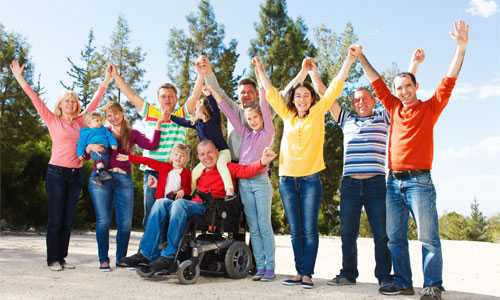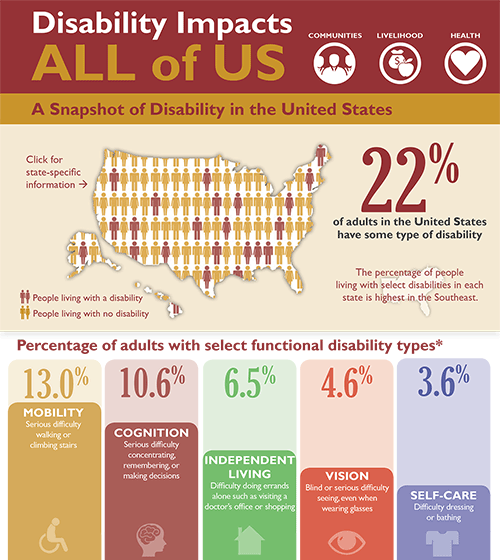Key Findings: Prevalence of Disability and Disability Type among Adults, United States – 2013
People with Disabilities: Who are they and what do we know?
The Morbidity and Mortality Weekly Report (MMWR) has published a new report describing the percentage of adults with disabilities in the United States living in communities. This report is based on questions used for the first time in the 2013 Behavioral Risk Factor Surveillance System (BRFSS) that allow respondents to identify specific functional types of disability, such as mobility (serious difficulty walking or climbing stairs), cognitive (serious difficulty concentrating, remembering or making decisions), vision (serious difficulty seeing), self-care (difficulty dressing or bathing) and independent living (difficulty doing errands alone). According to this report, over 53 million adults living in communities in the United States have a disability. Highest percentages are generally found in southern states and lowest are mostly in mid-western and Rocky Mountain states. Although anyone can have a disability, and a disability can occur at any point in a person’s life, disability was more commonly reported by women, older people (65 or more years), and racial and ethnic minority groups. Although progress has been made since the passage of the Americans with Disabilities Act (ADA) twenty five years ago giving people with disabilities better opportunities to achieve their potential, studies consistently show that people living with a disability have poorer health than people without a disability, and that many of the health issues related to this poor health are preventable. This MMWR presents important information that public health officials and others can use to help understand and address the needs of people with disabilities in the United States.
Report Limitation: Currently, the BRFSS does not assess deafness or serious difficulty hearing. Therefore data on the number of people who have hearing difficulties at the state level was not collected. This results in a likely underestimate of the total number of people with disabilities in the U.S. presented in this report.
You can read the full report here.
Main Findings:
- 1 in 5 adults or over 53 million people in the United States have a disability of one form or another, with state-level estimates ranging from 1 in 6 (16.4%; Minnesota) to nearly 1 in 3 (31.5%; Alabama).
- The most common functional disability type was mobility disability, reported by about 1 in 8 adults.
- Over a third of adults 65 years or older reported any disability.
- Adults 45-64 years of age were more likely than other age group adults to report a cognitive disability.
- Individuals reporting a higher household income or education level were less likely to report having a disability, compared to individuals in lower income or education levels.
- Women were more likely to report any disability when compared with men (24.4% versus 19.8%). This was also seen for most of the disability types.
- Disability was more frequently reported by non-Hispanic blacks (29.0%) and Hispanic (25.9%) adults than by white non-Hispanic (20.6%) adults.
Implications:
- Although disability information has been collected in national surveys for many years, this is the first time functional disability type is included in a state-based health survey. This new information can help researchers and public health professionals better understand the makeup of adults with disabilities at a state level, and therefore, better plan programs to address the needs of the different disability populations.
- Variation among states in the percentage of people who reported a disability, with the highest percentage of disability generally found in states in the southern U.S., reinforces the importance of assuring that all people with disabilities receive the health care and support they need to improve the health and wellbeing of the entire population.
- Because middle-aged adults (45-64 years old) were more likely to report cognitive disabilities than adults in other age groups, further research can be used to help better understand reasons for this, and ways in which their unique needs can be addressed.
- Since the percentage of disability is higher among certain groups such as women, older people, and racial and ethnic minorities, it is important that the programs and resources available for people with disabilities address the needs of these populations.
- The ADA has made a positive difference in the lives of those who have disabilities, providing better access to buildings, transportation, and employment. However, health disparities (differences in health) between people with and without disability are still present. Furthermore, disadvantaged people, namely those with lower education or income and those who are unemployed, are still more likely to report a disability. Working together we can help ensure that children and adults with disabilities receive needed programs, services and health care throughout their lives so that they can achieve their full potential, live a quality life, and experience independence in their communities.
What is CDC doing to improve the lives of people with disabilities?
CDC supports 18 state-based disability and health programs and four National Public Health Practice and Resource Centers which promote healthy lifestyles and work to improve quality of life for people with disabilities. The primary goals of the state programs are to
- Increase health promotion opportunities for people with disabilities;
- Improve access to healthcare services for people with disabilities; and
- Improve emergency preparedness for people with disabilities.
The CDC’s Disability and Health website also provides information and resources that public health practitioners, healthcare providers and people interested in the health and wellbeing of people with disabilities can use to increase awareness about disability inclusion. This information and the resources can help ensure that everybody, with and without disabilities, can live, work, learn, and play in their communities.
We encourage you to visit the newly updated Disability and Health website to find helpful information about disability inclusion and learn more about
- Barriers that people with disabilities usually experience in their communities;
- Strategies to create inclusive communities; and
- Resources to include people with disabilities in public health programs and activities.
CDC also maintains the Disability and Health Data System (DHDS), an online interactive tool that provides instant access to state-level, disability-specific health data. Users can customize the disability and health data they view, making it easy to identify health differences between adults with and without disabilities. In a future update of the system, users will be able to find health data by functional disability type.
Key Findings Reference:
Courtney-Long EA, Carroll DD, Zhang Q, et al. Prevalence of Disability and Disability Type among Adults, United States – 2013. MMWR Morb Mortal Wkly Rep 2015; 64: 777-783.
More Information:
To learn more about what CDC is doing to include people with disabilities in public health research and health promotion activities, please visit https://www.cdc.gov/ncbddd/disabilityandhealth/index.html.
To find more information about the health of people with disabilities, please visit http://dhds.cdc.gov/.
Glossary
Behavioral Risk Factor Surveillance System (BRFSS): The nation’s premier system of health-related telephone surveys that collect state data about U.S. residents regarding their health-related risk behaviors, chronic health conditions, and use of preventive services
Functional types of disability: Self-reported difficulties with certain activities and functions, including
- Serious difficulty walking or climbing stairs (mobility)
- Serious difficulty concentrating, remembering or making decisions (cognitive)
- Serious difficulty seeing (vision)
- Difficulty dressing or bathing (self-care)
- Difficulty doing errands alone (independent living)
- Page last reviewed: August 20, 2015
- Page last updated: August 20, 2015
- Content source:


 ShareCompartir
ShareCompartir

